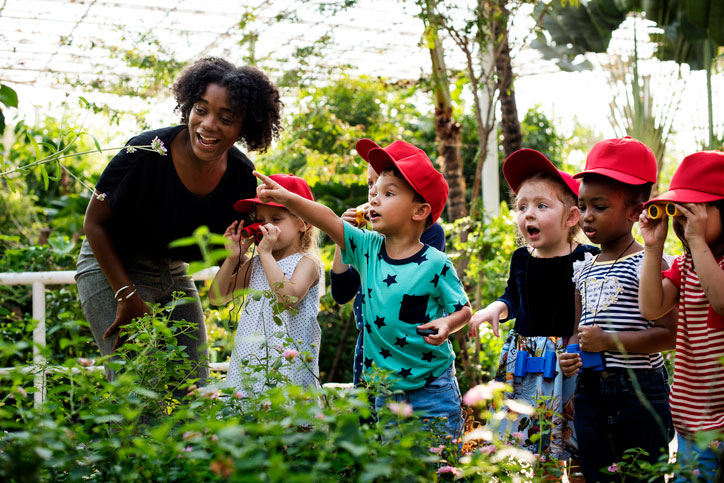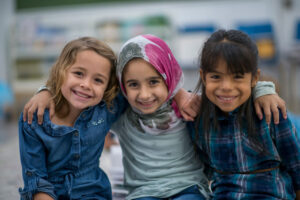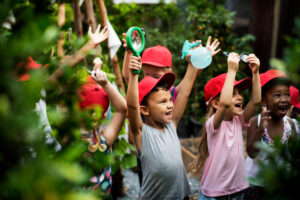5 Ways To Put Your Money Where Your Mouth Is In Building Supportive Relationships with Your Students
10/13/2021

Relationships, relationships, relationships!
We know that having positive, trusting relationships in their lives this is the number one indicator of student success...
Then why don't we double down on relationships?
We push the curriculum. Many of us are getting students ready for the first assessment, then the next assessment, and then we change our instruction in order to get them ready for the next test. We tell our teachers they need to be on a specific page on a certain day, that we must make it through all the curriculum and tests.
The anxiety we create in our students is visible. What we don't talk enough about is the anxiety it creates in our teachers to perform on these tests and make it through the curriculum.
Americans are so driven by data. We love data. Tracking it over time, comparing it across the grade levels and schools. How do we know we are collecting the right data?
Here is what I am not saying...do away with testing. I do believe we need to assess where our students are on a continuum of learning targets. I am also not saying that covering curriculum isn't important, but I am asking to what extent? My question is how can we do this without creating exorbitant amounts of anxiety?
Let's double down on the right data, the data that is going to support relationships.
The truth...data is not going away. Let's get relationship data into the hands of the people that need to make decisions. Relationship data will support a classroom teacher with students seated in front of them, a principal who drives the culture, a superintendent who allocates funds, and a legislator that creates policy and rules. We need this data to support strong healthy relationships in our families and in our schools.
Here are five pieces of data we can track to double down on creating strong lasting relationships.
1 -- Tracking Trusting Relationships For Every Child
 All the statistics and research tell us that the number one combatant against adverse childhood effects is resiliency. How people deal with traumatic events is different for everyone. Dr. Bruce Perry speaks to the fact that positive trusting relationships are the number one factor in building resiliency. In fact, the more of these types of relationships in a child's life, the higher their resiliency factor. If our staff believes this as a universal belief, we then must put time into building more trusting relationships with our students, and actually tracking it. How do we track this?
All the statistics and research tell us that the number one combatant against adverse childhood effects is resiliency. How people deal with traumatic events is different for everyone. Dr. Bruce Perry speaks to the fact that positive trusting relationships are the number one factor in building resiliency. In fact, the more of these types of relationships in a child's life, the higher their resiliency factor. If our staff believes this as a universal belief, we then must put time into building more trusting relationships with our students, and actually tracking it. How do we track this?
One of the most powerful activities in my experience was at Somers Middle School in Somers, Montana. Inspired by a partnership and work with Rick Wormeli, author of Meet Me in the Middle, in our district we put more time into meeting the needs of all students through strong relationships. In our teacher workroom, which was rather large, 215 pictures on poster paper were placed on the walls. Our task from our principal was to write our name on the outside of every picture where we had a strong relationship with that child.
What defines a strong relationship?
Here are some criteria we used to define a strong relationship with a child: know their name, know their family, know at least 1-2 academic likes/dislikes, and know 1-2 things non school related. If this student comes to you routinely to talk about academics or non-academic things, this is an automatic name on the poster, and the previously mentioned criteria is skipped.
What we found from this activity was several students that had multiple staff names on their posters. There was a direct connection to successful students and the number of trusting close relationships. The most difficult part was seeing the number of students who walked our hallways and attended our classes that had little or no trusting adults connected to them. This was painful to many of us.
The principal gave us a challenge. Using a red colored marker, we were to choose two students to connect with starting the following day and start building a strong relationship. We stressed the importance of really putting in time with these relationships. Many of us used the 2 X 10 strategy to connect...2 minutes for days straight. We talked about non academic things with these students, their likes and dislikes, sports, family, etc...
Over the next couple weeks, we revisited this activity and debriefed our experiences with these students. We believed relationships and school culture were dramatically affected for the positive. It was hard to quantify this positive increase, but we felt we could also see it in increased grades and lowered discipline referrals. Personally, I believe this would be a great doctoral thesis.
This is just one idea for tracking positive relationships. This activity can be modified to a classroom or smaller group of students. The power of doing it school-wide is the fact that we owned ALL our students, as well as letting staff know I can still have a relationship with a student that isn't in my class!
Quantifying the social and emotional effect of our work can and always will be argued. The latest research has stated as recently as 2020, that there is an $11:$1 ratio. For every $1 spent on social and emotional learning, there is an $11 return. That could mean fixing the problem early and building a great foundation first! This of course is the age old argument...shall we put more money into educating our youth, or money building our prison system.
This takes time, training, and a belief that relationships come first. We know time is money in education. We must put our money where our mouth is and give time and resources to tracking positive relationships.
2 -- Tracking Allocated Funds to Develop Strong Relationship
 How do we create trusted relationships with our students? First, we must have the capacity to like our students. This may sound patronizing, but there are educators who do not have the capacity to build strong relationships with their students. For some, it may be that they don't know how to connect and interact with students because they don't have the skills, language, and patience. For others, they may be clueless. They do not see the need to connect and build strong relationships as teaching the curriculum in their minds is their only job.
How do we create trusted relationships with our students? First, we must have the capacity to like our students. This may sound patronizing, but there are educators who do not have the capacity to build strong relationships with their students. For some, it may be that they don't know how to connect and interact with students because they don't have the skills, language, and patience. For others, they may be clueless. They do not see the need to connect and build strong relationships as teaching the curriculum in their minds is their only job.
For educational leaders, providing opportunities for our staff to create positive childhood experiences (PCE's) is vital to creating an environment where it is not only strong with relationships, but expected and practiced by all. Adverse childhood effects (ACE's) can make relationship building for students, as well as many adults that have not dealt with their own ACE's, very difficult. Leaders can start by finding professional development opportunities that help staff build resiliency which in turn can support students with much the same types of learning experiences.
Next, they can then help plan school-wide activities, events, and social experiences that create memories and opportunities for both staff and students to have fun. This is one of the quickest ways for staff to build relationships with students through fun activities and sharing positive experiences. Encouraging staff to enjoy themselves, to enjoy and spend time with students during these experiences may need to be modeled, discussed, and debriefed. Some teachers are naturals at building relationships, while others need strategies modeled for them.
We must put our money where our mouth is by providing professional development and positive childhood experiences seems a logical first step.
3 -- Creating Common Social and Emotional Learning Experiences in PreK and K
 I am a firm believer in Dr. Bruce Perry's Nuerosequential Model for Therapeutics (NMT). In the NMT model, he believes that the science behind brain development helps determine success for treatment of mental health issues. From this model we know that the brain stem, formed in the first couple months of a baby, develops the sensory system and this is when the state of regulation starts here. The diencephalon is directly located above the brainstem and is developed by 4-6 years old. It is responsible for somato-sensory integration. The next portion of the brain is the limbic system which is developed through puberty. The limbic area is responsible for social and emotional growth. The last portion of the brain is the cortex which isn't fully developed until 25 years old. It is responsible for abstract thinking and reasoning.
I am a firm believer in Dr. Bruce Perry's Nuerosequential Model for Therapeutics (NMT). In the NMT model, he believes that the science behind brain development helps determine success for treatment of mental health issues. From this model we know that the brain stem, formed in the first couple months of a baby, develops the sensory system and this is when the state of regulation starts here. The diencephalon is directly located above the brainstem and is developed by 4-6 years old. It is responsible for somato-sensory integration. The next portion of the brain is the limbic system which is developed through puberty. The limbic area is responsible for social and emotional growth. The last portion of the brain is the cortex which isn't fully developed until 25 years old. It is responsible for abstract thinking and reasoning.
Building a strong foundation of social and emotional learning (SEL) starts as soon as students enter our school systems. I believe the stronger the foundation of understanding ourselves and being able to express our needs is critical pre K and kindergarten programming. As mentioned before, the 11:1 ratio of dollars spent on SEL is the most important investment in building a child's social and emotional toolbox.
As educators we can do this through a strong SEL curriculum coupled with effective instruction. It can't just be the curriculum, it has to be a philosophy and language that is used with our students throughout the entire time we are with them. It is how we create and sustain a strong culture built around these beliefs. It is how we live out every action we model, every word we use, and how we interact with everyone in our learning environment. We can do this through creating a plethora of positive childhood experiences and putting an emphasis on making sure every child has at least one caring adult in the school.
We must put our money where our mouth is and value social and emotional learning by finding programs and training that will start building a strong foundation in prekindergarten and kindergarten programs.
4 -- Providing Positive Childhood Experiences (Opposite of ACE's)
 We know that ACE's can stymie the growth of a child. Their resiliency factor is the one key to future success and overcoming theses ACE's. Educators can help build this resilience factor in a multitude of ways, one that we should focus on are positive childhood experiences (PCE's). PCE's are the exact opposite of ACE's. In fact, the more PCE's for a child, the higher their resiliency factor.
We know that ACE's can stymie the growth of a child. Their resiliency factor is the one key to future success and overcoming theses ACE's. Educators can help build this resilience factor in a multitude of ways, one that we should focus on are positive childhood experiences (PCE's). PCE's are the exact opposite of ACE's. In fact, the more PCE's for a child, the higher their resiliency factor.
Creating PCE's for our students may sound time consuming. I argue, would you rather proactively put time up front with this child through PCE's or time and resources in a multitude of therapies and expensive interventions in a reactive model?
Positive Childhood Experiences can look as simple as time to work with friends in a collaborative and safe environment. Trust between all parties is important in this safe environment. Educational leaders, such as teachers, can support students by setting boundaries, modeling language and actions, and checking in with students. Starting with nonacademic collaborative experiences helps build friendships, trust, and safety. This can be done in the classroom every day. Using this same model and expectations can then be used in academic collaborative learning experiences. Other ideas for the classroom include goal parties, dance parties, classroom challenges, parent involvement activities, celebrations of learning, and more.
School leaders can create PCE's through school-wide events. Creating a community that encourages a positive culture must also provide for activities to support culture building. PCE's such as a school carnival, bingo night, Christmas cookie decorating, parent night, school-wide challenges, grade level challenges at assemblies, fun interactive assemblies or presenters, game days, BBQ, carnival, inflatables, and so much more.
A fine balance exists with providing PCE's for students and driving academics. The ability to integrate the two will be advantageous to everyone. Students and staff that enjoy school have a much higher chance for success. Critics will say school is about academics, and the time spent on school-wide events is a waste of instructional time. My question is, how can we can we not spend time building PCE's from the research we now know?
We must put our money where our mouth is and find time and resources to create PCE's for not only our students, but our staff and community as well!
5 -- Finding the Correct People Through Hiring
 When creating an environment that believes school culture is the number one priority for success, finding the correct people is essential. Unfortunately, there are educators that believe spending time on social and emotional learning and building relationships is a misuse of time or it is "hippy-ish." I cringe when I hear those words and statements.
When creating an environment that believes school culture is the number one priority for success, finding the correct people is essential. Unfortunately, there are educators that believe spending time on social and emotional learning and building relationships is a misuse of time or it is "hippy-ish." I cringe when I hear those words and statements.
We must continue to battle the fact that working on mental health and making it safe to discuss and address is the most important endeavor we have in education right now. Mental health issues are just as important if not more than academics.
Finding employees that accept this foundational belief is critical. I believe we can move schools forward by addressing mental health, and academics will have a correlative increase, too!
We must put our money where our mouth is and hire people who put relationships first, understand the mental health needs of students, and want to make a difference in our school systems.
- Learning How to Say No and Set Boundaries with Parents - November 21, 2022
- If You Had Only One Behavior Strategy to Use in Your Classroom, What Would It Be? - September 26, 2022
- Live Your Code: 7 Strategies That Will Help You Be the Most Effective Educator You Can Be - August 15, 2022









